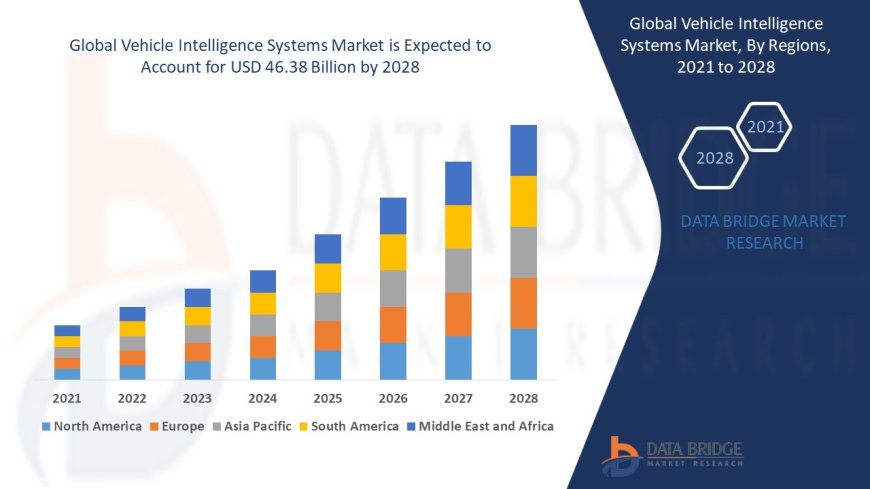Smart Wheels: The Rise of Vehicle Intelligence Systems in the Global Automotive Arena

Vehicle Intelligence Systems (VIS) represent a critical leap in the evolution of automotive technology. These systems include advanced electronics and software integrated into vehicles to enhance driving safety, optimize traffic flow, improve vehicle efficiency, and support autonomous functions. VIS incorporates technologies such as adaptive cruise control, blind-spot detection, lane departure warnings, traffic sign recognition, collision avoidance systems, and driver monitoring tools. Growing demand for smart mobility, increasing safety regulations, and rapid advancements in artificial intelligence and sensor technologies are driving the adoption of these systems across the globe.
Automotive manufacturers are increasingly investing in research and development to create intelligent vehicles that meet consumer expectations and regulatory demands. Governments and regulatory bodies are also actively supporting innovation through funding and policy frameworks. The intersection of connectivity, automation, and intelligence is transforming traditional vehicles into smart machines capable of learning, adapting, and interacting with their environment.
Vehicle intelligence systems market size is valued at USD 46.38 billion by 2028 is expected to grow at a compound annual growth rate of 12.96% in the forecast period of 2021 to 2028.
Access Full 350 Pages PDF Report @
https://www.databridgemarketresearch.com/reports/global-vehicle-intelligence-systems-market
Market Size
The global Vehicle Intelligence Systems market is experiencing rapid expansion. The market was valued at approximately USD 16.4 billion in 2023 and is projected to reach USD 36.8 billion by 2030, growing at a compound annual growth rate (CAGR) of over 12%. This robust growth reflects rising consumer awareness of road safety, increased automobile production, and the shift toward electric and autonomous vehicles.
North America accounts for a significant portion of the market due to early adoption of advanced automotive technologies and strong presence of key automotive and tech companies. Europe follows closely, driven by stringent safety regulations and widespread integration of driver assistance systems. Asia-Pacific, particularly China, Japan, and South Korea, is emerging as a fast-growing market owing to rising vehicle ownership, rapid urbanization, and growing investments in automotive innovation.
Commercial vehicles are increasingly integrating VIS features to reduce accident risks and enhance operational efficiency. Passenger vehicles dominate the market segment-wise, but the commercial sector is expected to grow faster during the forecast period due to the adoption of fleet intelligence solutions.
Market Share
Major automotive players such as Bosch, Continental AG, Denso Corporation, Delphi Technologies, Mobileye (Intel), and Valeo dominate the vehicle intelligence systems landscape. These companies hold substantial market share owing to their deep expertise, strong R&D capabilities, and global manufacturing networks.
Mobileye, with its strong AI-based vision technology, is leading in the domain of advanced driver-assistance systems (ADAS) and autonomous driving modules. Bosch and Continental are prominent in both hardware (like sensors and radar systems) and integrated software systems, enabling them to provide end-to-end VIS solutions to OEMs. Startups and technology entrants are also gaining ground with innovative, lightweight, and more affordable solutions.
Automakers such as Tesla, BMW, Ford, Toyota, and Mercedes-Benz are incorporating in-house and third-party VIS technologies into their vehicles. Partnerships between tech companies and automotive manufacturers are also shaping the competitive landscape and redistributing market share based on technological capabilities and scalability.
Market Opportunities and Challenges
Opportunities in the Vehicle Intelligence Systems market are abundant. The ongoing transformation toward autonomous vehicles is a major driver. As vehicles move from level 1 to level 5 autonomy, the demand for sophisticated VIS components will increase exponentially. The electrification of vehicles opens new possibilities for energy-efficient, software-defined vehicles that heavily rely on VIS technologies. Urban mobility trends such as ride-sharing and smart fleet management present additional market potential for VIS-enabled vehicles.
Rising demand for connected vehicles and the rollout of 5G networks further enhances the prospects for real-time data communication, predictive maintenance, and smart navigation systems. Regulatory mandates for features like automatic emergency braking (AEB), electronic stability control (ESC), and blind-spot detection in Europe, the U.S., and parts of Asia have also created a compulsory market for VIS.
However, the market is not without challenges. High implementation costs remain a barrier, particularly in emerging markets. Complexity in system integration and the need for standardization across OEMs and suppliers create technological and operational bottlenecks. Concerns over data privacy and cybersecurity also hinder broader adoption of connected intelligence systems. Furthermore, VIS technologies require robust validation and testing processes to ensure reliability in diverse real-world conditions, which adds to development time and cost.
Market Demand
Demand for Vehicle Intelligence Systems is being propelled by multiple factors. Consumers increasingly prioritize safety, convenience, and connectivity in their vehicle purchasing decisions. The shift in consumer expectations is compelling manufacturers to embed intelligent technologies in even mid-range vehicle segments.
Fleet operators and logistics companies are embracing VIS to enhance driver behavior monitoring, route optimization, and accident prevention. Insurance companies are encouraging or requiring the use of telematics and driver-assist systems as part of usage-based insurance models. These developments reflect a broader shift toward data-driven transportation.
Public sector demand is also growing. Municipalities and governments are deploying smart traffic management systems and intelligent transport infrastructure, integrating vehicle intelligence data to reduce congestion and improve safety. Military and defense sectors are showing interest in VIS for autonomous military transport and surveillance applications.
Market Trends
Several key trends are shaping the future of the Vehicle Intelligence Systems market. Artificial intelligence and machine learning are enhancing the capabilities of VIS through real-time decision-making, pattern recognition, and adaptive learning. Camera and sensor fusion technology is gaining momentum, allowing systems to merge data from multiple sources like radar, LIDAR, and cameras for more accurate environmental perception.
The rise of software-defined vehicles is shifting the focus from hardware-centric to software-first designs. Over-the-air (OTA) updates allow manufacturers to roll out new VIS features and improvements without physical recalls. Edge computing is enabling faster and more efficient processing of vehicle data locally, reducing latency and enhancing responsiveness.
Autonomous driving continues to be a dominant trend. Companies are racing to develop Level 4 and Level 5 autonomous solutions, with VIS at the core of these systems. Vehicle-to-Everything (V2X) communication is another emerging area, enabling vehicles to interact with other cars, infrastructure, and pedestrians to further enhance situational awareness.
Sustainability is influencing VIS design. Energy-efficient sensors, lightweight materials, and optimized processing units are being developed to reduce the energy footprint of VIS systems, aligning with the goals of green mobility.
Contact Us:
Data Bridge Market Research
US: +1 614 591 3140
UK: +44 845 154 9652
APAC : +653 1251 975
































































![https //g.co/recover for help [1-866-719-1006]](https://newsquo.com/uploads/images/202506/image_430x256_684949454da3e.jpg)

























![How Smart PMs Scale Their Careers in Any Org [TPG Live Recap]](https://tpgblog.com/wp-content/uploads/2025/06/2025-06-12-thumbnail-action.png?#)


















































